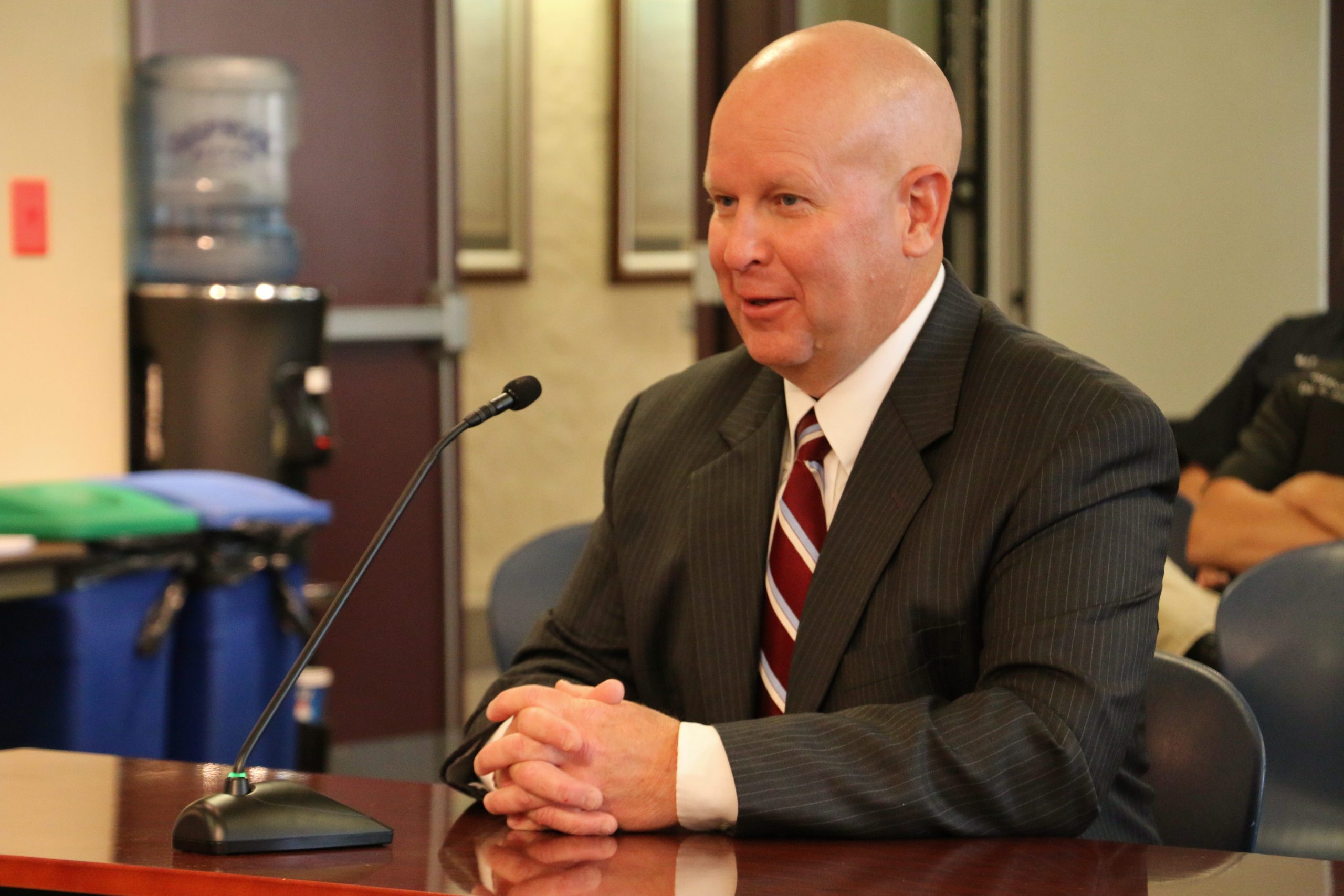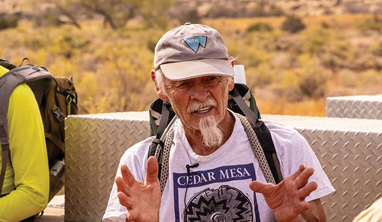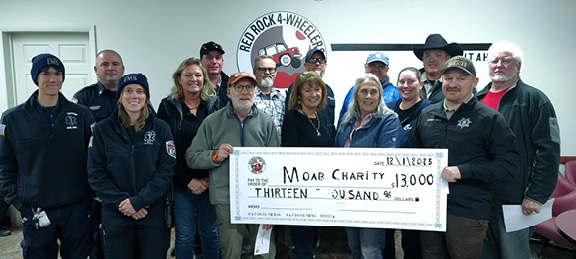Some information may be outdated.
Seven months after its former police chief resigned, the City of Moab is getting closer to naming Interim Chief Steve Ross’ replacement.
Over the last two weeks, Moab City Council members have interviewed two finalists for the job: Parowan Police Chief Ken Carpenter, and Keith McPheeters, the former deputy police chief of Farmington, New Mexico.
Moab City Council member Rani Derasary said the city advertised the position at the local, state and national levels, drawing more than 40 applicants from across the country. With the help of the Police Executive Research Forum, she said, employee review committees narrowed the field of applicants down to four finalists. One of those finalists later withdrew his name from consideration, and Derasary said city staff subsequently recommended that the council interview Carpenter and McPheeters.
McPheeters, who was born in Utah and grew up in Idaho, spent more than 24 years with the Farmington Police Department. He said he resigned from the force after lawmakers in New Mexico changed that state’s Public Employees Retirement System, making it “almost impossible” for him to remain employed there.
Carpenter has served as Parowan’s top law enforcement official since October 2011; before that time, he worked as an officer with the Cedar City Police Department for more than seven years, following a two-decade career in the U.S. Marine Corps. He currently oversees a department that includes five full-time and four part-time officers in the small southwestern Utah town of about 2,800 people.
Carpenter strives to improve communications, relations
Three years into his current job, the Utah Association of Police Chiefs named Carpenter the Small Agency Police Chief of the Year, but after six-plus years with that department, he said the time has come for him to move on.
“I’ve done pretty much all I can do for Parowan,” he told the council during an interview on Monday, April 17.
Carpenter interviewed for the local position at a time when morale within the Moab City Police Department is up, following a sometimes-difficult 2016. He said he’s especially impressed to see a budgetary increase in funding for police training, telling the council that such investments are essential to a department’s long-term success.
“If we’re not training properly, then we’re not enforcing the law properly,” he said.
If he’s selected for the job, Carpenter said that efforts to build improved communications and relations would be among his first priorities.
As he talked to people in the community, he said he grew concerned to hear many of them say, “I really don’t have a view” of the department – mainly because they haven’t had any interactions with local law enforcement.
One of the best places to start with community-oriented policing, he said, is at the schools: A school resource officer not only protects students, but also ensures that kids’ interactions with police aren’t limited to arrests down the road.
In addition to public outreach, Carpenter said he’d work to strengthen ties with other law enforcement agencies, from the Grand and San Juan County Sheriff’s offices, to the Utah Highway Patrol and the Utah Attorney General’s Office, to the U.S. Drug Enforcement Administration (DEA) and the Federal Bureau of Investigation (FBI).
Carpenter said he recently met with a DEA director who reportedly told him that he would like to send agents down to conduct controlled drug buys, and perform undercover work.
“He recognizes that there’s a huge drug problem down here in southern Utah, and especially in this part of the state, where they haven’t had any influence,” Carpenter said. “One of the things that he would really like to be able to do is come in with a drug task force to be able to help us curb the problems that are affecting our community.”
Many other people he’s spoken with have told him that Moab has a drug problem that needs to be addressed, he said.
Under his watch, he said the department would not go after drug users, but should instead target those who are manufacturing and distributing controlled substances such as heroin, cocaine and methamphetamine.
Likewise, he said it’s not the department’s job to arrest undocumented immigrants who are pulled over during traffic stops, simply because they may be violating federal immigration laws.
“There’s a lot of good, hardworking people here that may be here illegally; there’s a lot of them that have been raised here, and now are raising families of their own,” he said.
Instead, he said, the department should set its sights on violent felons and those who are “harmful to the community.”
“Those are the ones that we want to deal with; those are the ones that we may like to have (Immigration and Customs Enforcement) come in and help us with,” he said.
At the internal level, Carpenter would try to address problems he identified with the police department’s evidence storage room, which he called “substandard.” The department is not following “best practices,” he said, citing instances where weapons are being stored with drugs, when they should be locked away separately.
Looking inward, he said an officer-involved shooting in July 2015 of a former volunteer firefighter with the Parowan Fire Department was the most sensitive or critical incident in his law enforcement career.
The officer responded to a report that the man was beating a 12-year-old boy, and authorities have said the man pointed a gun at the officer before he was fatally shot.
The incident sent shockwaves through Parowan, and Moab City Council member Kyle Bailey questioned what Carpenter could have done better in terms of getting information about the incident out to the citizens.
“There seem to be some transparency issues with the community in that shooting,” Bailey said.
Carpenter said the Iron County Attorney’s Office – and not the police department – was responsible for releasing the initial statements on the incident.
“That really kind of hamstrung us, because … I think there was information that we probably could have provided that we weren’t allowed to provide at the time,” he said.
Still, he said the experience taught him the importance of getting information out to the media in a timely manner.
Moab Mayor Dave Sakrison said he’s “pretty impressed” with the comments he heard, but he asked Carpenter how he would accomplish everything he talked about.
“Even for our size, it’s still a pretty small staff, and there’s a lot of challenges as far as what we do here because we don’t have the manpower to do it,” Sakrison said. “Staffing’s going to be an issue.”
Carpenter said the answer to that question is largely up to the city’s elected officials, although he can tell them what his needs are.
Sometimes, he said, officials will have to consider which department’s needs are the most important.
“One of the things that’s key for a police department like this is to remain proactive,” he said.
McPheeters touts management, grant writing skills
McPheeters, who has also interviewed for other police chief positions from Colorado to Idaho and Washington state to Brigham City, said that although he most recently worked for a larger department, the management principles are still the same.
Apart from his management skills, McPheeters called himself an experienced grant writer who secured more than $3 million for his department. During his time in Farmington, he said, he obtained grant funding for six school resource officer positions in the community. The investment, he said, paid huge dividends, leading to a 40 percent drop in juvenile crime, and an even bigger decline the following year.
In addition to investing in school resource officers, he said he believes in encouraging people in the community to help mentor young people who may run into trouble with the law.
Like Carpenter, McPheeters said he’s found that the “vast majority” of local residents he spoke with are uninformed about the police department’s role in the community. To remedy that situation, he said he would step up the department’s community outreach efforts – particularly through social media platforms like Facebook.
“I think we need to do a better job of reaching out to our citizens,” he said.
Within the department and at city hall, he said he’s witnessed a “great atmosphere” among employees and officials who are ready to embrace the future.
“It’s been a rough couple of years (for the police department), and I think they’re yearning to put that behind them,” he said.
Like Moab, Farmington is a diverse community, with large populations of Hispanic residents and Native Americans. During his time with that department, he said it went out of its way to ensure that it recruited a workforce that resembles the community.
When asked about the Trump administration’s controversial stance toward undocumented immigrants, McPheeters said he’s adamant that law enforcement must respect anyone who’s been the victim of a crime – regardless of their immigration status or the language they may speak. The department must also work to ensure that they receive professional, unbiased service, he said.
He takes a much dimmer view toward those who are suspected – or have been convicted – of violent or property-related crimes, though.
“We’ll work closely with all available resources … to take care of hardened criminals,” he said.
Farmington, he said, is home to a large population of people who are involved in Mexican drug cartels like the Sureños. As deputy chief, he said he partnered with federal authorities to identify the most “difficult and notorious” criminals who were tied to the cartels, and followed through until they were ultimately sentenced on federal charges.
“It has had some wonderful impacts,” he said, noting that younger generations of cartel members lost older “mentors” who wound up in prison.
While Farmington is located along a major heroin, cocaine and methamphetamine trafficking route, it’s also a short drive away from recreational marijuana dispensaries in Colorado. In the time since New Mexico’s northern neighbor legalized that use, McPheeters said he witnessed an uptick in the number of people who are driving while they are impaired, among other problems.
McPheeters said he has “very strong” opinions that unlawful and inappropriate drug and alcohol use leads to serious problems, and his message to drug traffickers is, “You’re not welcome to ply that trade here.”
Switching to the subject of mental illness, he suggested that law enforcement officers still have much to learn in terms of how they respond to a combative person who may be suffering from conditions like schizophrenia.
“In this day and age in our society, that skill set is something that we have been slow to recognize as being important,” he said. “In law enforcement, over the years, we’ve become very proficient at teaching the skill set of being a police officer. We can teach anybody to shoot; we can teach anybody how to drive; we can even be pretty successful about how to teach them to roll around on the ground with somebody.”
But as a profession, he said, law enforcement has failed in teaching people when those skills are appropriate.
As they go through police academy training, he said, officers are taught that “everybody” is lying to them, and that “everybody” is going to try to kill them.
“We just engrain this into them,” he said.
Of course, there are still times when it’s appropriate to use force, he said, and officers still need to learn those skills. However, he said he wants to make sure that all of his department’s employees would take advantage of crisis intervention training that the state offers.
The trick, he said, is to remember the original tenet that officers learn: “We’re here to help.”
Applicants hail from Parowan, Utah; Farmington, N.M.
Appreciate the coverage? Help keep local news alive.
Chip in to support the Moab Sun News.





